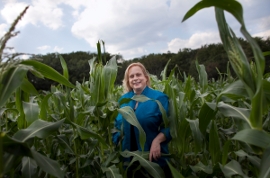A Hidden History of the World
By Helene Ragovin
How foods like corn, rice and wheat tell the story of human culture through the ages

Staples like corn have had great significance in world history, says Ina Baghdiantz McCabe. Photo: Alonso Nichols
Wheat. Rice. Corn. Potatoes. Bananas. Simple staples, yes, but also a window into the past. Food has influenced civilization in immeasurable ways—from where humans chose to settle to how they worshipped their deities. It has sparked worldwide exploration, mass migrations, revolution. It’s a marker of social attitudes and ideologies.
Indeed, while the teaching of history is often presented through the lens of diplomatic, political or military events, looking at the details of daily life, such as what people ate—or, for that matter, what they wore or what they owned—can also illuminate the past. In her popular course “Consumption, Power and Identity: History of Food and Clothing,” Ina Baghdiantz McCabe does just that.
Very often history focuses on elites, but the history of consumption is a way of understanding other, less-represented groups in society. “It’s a history of daily life,” says Baghdiantz McCabe, the Darakjian and Jafarian Professor of Armenian History in the School of Arts and Sciences.
While the importance of food is a common thread through all cultures, “what’s interesting is how food can show great cultural diversity and great diversity in beliefs,” Baghdiantz McCabe says.
“All societies have had staples: in the Americas, it was corn; in the Mediterranean, wheat; in Asia and Africa, rice,” she says. “What’s common is that when there is a staple food, it very often has a religious sentiment that’s attached to it, a sense that it’s a gift from the gods and has to be safeguarded. There are certain rituals associated with eating those staples. Those are rituals that have, for the most part, disappeared, but in the past, there was a clear moral and religious aspect to food staples.”
The vestiges of those rituals remain, for example, in practices like Christian communion—bread as the body of Christ—or the Jewish Sabbath blessing over challah, both originating in cultures that relied on wheat. “The staples might be different, the ritual might be different, but that main staple has a lot of significance,” Baghdiantz McCabe says.
Food can also play a critical role in history. Bananas, for example, have fueled the politics of 20th-century Central America. A major factor in the U.S. involvement in the 1954 coup in Guatemala, which led to a long series of repressive military regimes, was concern by United Fruit that its banana franchise there was threatened. In Ireland, the failure of the potato crop was a touchstone in its 19th-century history and the subsequent Irish diaspora.
In a broader sense, Baghdiantz McCabe’s course focuses on the social connotations that wealth and material things carry at different times in history. Take the 1500s. In Europe, there was a marked increase in social mobility, as merchant classes became wealthier and started breaking rigid social patterns. “What you own—and what you desire—starts defining your social place and social status,” Baghdiantz McCabe says.
Voting with Their Checkbooks
Baghdiantz McCabe began teaching the course in 1998, and six years ago she began offering it in the summer as well. Since she first developed it, enrollment has grown almost tenfold, to 120 students, reflecting an increasing awareness of food-related issues. Baghdiantz McCabe also points to the popularity of books like Michael Pollan’s The Omnivore’s Dilemma and Eric Schlosser’s Fast Food Nation and movies like Food Inc. in driving up enrollment.
Students want to know about biotechnology, genetic modification and sustainability, she says. In the class, she covers those topics and more. “We talk about hunger and famine, for example,” she says. “We’re not simply studying what was eaten at the king’s table in the 17th century. There are real problems that can be examined through the study of food.”
Another boon to the course is the considerable amount of new scholarship examining food, dress and other quotidian subjects, Baghdiantz McCabe says. Her students read Caroline Weber’s Queen of Fashion: What Marie Antoinette Wore to the Revolution, which chronicles the politics of the time via the queen’s wardrobe (her refusal to wear a whalebone corset shook the Bourbon-Hapsburg alliance, for example), and Karl Gerth’s China Made: Consumer Culture and the Creation of the Nation, which looks at early 20th-century Chinese nationalism and revolution through the political lens of consumerism.
In colonial Boston, patriotic resistance was expressed by boycotting imported tea. Baghdiantz McCabe praises a new book by her colleague Benjamin Carp, Defiance of the Patriots, which highlights the importance of the Boston Tea Party in the American Revolution. Baghdiantz McCabe’s own work on coffee and the birth of cafés is also part of the readings.
During the past decade or so, a genre of popular books has emerged that detail historical connections of specific foodstuffs like cod or bananas. “These new books are coming out by the bushel,” Baghdiantz McCabe says. Naturally, some promote an activist point of view, so she urges her students to examine all sides of an issue.
Food and consumption isn’t just a way to look at the past; it’s a way to understand the present, too. The rise of consumerism in the U.S. after the end of World War II is a distinctive element of our time—never before in history has mass consumption influenced the social, political and economic landscape to such an extent. And during the past 20 years in particular, Baghdiantz McCabe says, a new type of “informed consumerism” has begun to change the American mindset.
“People are voting with their checkbooks. They are boycotting things they don’t believe in,” she says. “They are looking for fair-trade products and organic food, or clothing that’s made in the U.S. under good labor conditions. These things have become important to some consumers—at least the consumers that can afford to have a choice.”
Helene Ragovin can be reached at helene.ragovin@tufts.edu.
